![]()
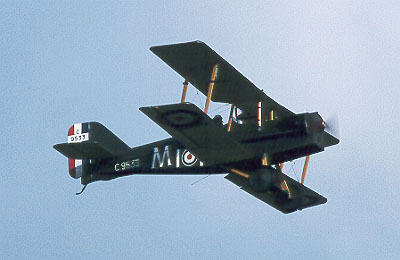
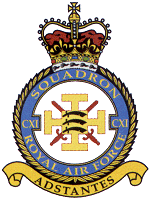 Not many perhaps, but some
of the squadrons of the Royal Air Force have adopted names. Often given
by the public or a flamboyant press, the names bestowed on these units
now have little or no relevance to today’s tasking. Stretching back to
its birth in 1916 Palestine, 111(F) Squadron will forever be known by
the service and public alike as 'Treble One'.
Not many perhaps, but some
of the squadrons of the Royal Air Force have adopted names. Often given
by the public or a flamboyant press, the names bestowed on these units
now have little or no relevance to today’s tasking. Stretching back to
its birth in 1916 Palestine, 111(F) Squadron will forever be known by
the service and public alike as 'Treble One'.
Drawn from a nucleus of 14 Squadron at Deir-el-Ballah, Bristol Scouts were the initial mount for 'Treble One'. August 1918 saw the squadron's SE5s carrying out devastating attacks on the enemy in retreat, and at Wadi el Far’a in September, attacked the enemy troops with more than 100 20lb bombs and 13,000 rounds of ammunition. The attack left thousands of vehicles wrecked in the sand.
The end of hostilities saw the squadron
briefly disbanded, returning to its roots when renumbered as 14 Squadron
at Ramleh. Reborn at Duxford on 1 October 1923, it flew in turn Siskins,
Bulldogs and Gauntlets, all tending to be 'flat-out' at around 120- 150 mph. It was a quantum
leap in 1937 (if such things existed then) for the unit to be the first
to equip with the Hawker Hurricane, with a maximum speed of over 300 mph.
It was while equipped with this machine that Commanding Officer Squadron
Leader John Gillan grabbed headlines all over the world by flying his
Hurricane from Edinburgh to Northolt at a speed of 408 mph.
150 mph. It was a quantum
leap in 1937 (if such things existed then) for the unit to be the first
to equip with the Hawker Hurricane, with a maximum speed of over 300 mph.
It was while equipped with this machine that Commanding Officer Squadron
Leader John Gillan grabbed headlines all over the world by flying his
Hurricane from Edinburgh to Northolt at a speed of 408 mph.
Acklington, Northumberland was where 'Treble One' received the news of the outbreak of the Second World War, and on 29 September 1939, a mere 26 days after hostilities commenced, the new C/O, a certain Squadron Leader Harry Broadhurst shot down a Heinkel 111 off the north-east coast. The Battle of Britain saw 111 Squadron at Croydon and Debden, and on 10 July 1949 they shot down three bombers from a force attacking a convoy in the English Channel. The battle increased during the following weeks, with Croydon itself becoming the Luftwaffe’s target on 15 August, with 'Treble One' accounting for three Me110s. By the early days of September, with the battle at its height, the squadron had 'bagged' 94 enemy, but suffered the loss of 14 pilots. It was time for a move to the North for well-deserved rest and recuperation.
It was time also for a change of
mount to the speedier Spitfire, and duly rested the squadron returned
to the south, to North Weald and Debden, to harass the enemy with sorties
into France.  Hampering the
passage of The Gneisenau and the Scharnhorst through the
Channel and covering the assault on Dieppe were both tasked to the unit
before foreign climes once more beckoned. It was back to the Middle East,
in fact to North Africa, that the squadron went to assist the completion
of the rout of Rommel's Army. November 1942 saw Operation 'Torch', where
a vast armada of aircraft and convoys spilled onto the North African coastline.
On 1 May 1943, 'Treble One' fought its last battle in the skies over Africa,
the tally of seven enemy shot down brought the squadron total to 52 –
the highest of any unit in the theatre.
Hampering the
passage of The Gneisenau and the Scharnhorst through the
Channel and covering the assault on Dieppe were both tasked to the unit
before foreign climes once more beckoned. It was back to the Middle East,
in fact to North Africa, that the squadron went to assist the completion
of the rout of Rommel's Army. November 1942 saw Operation 'Torch', where
a vast armada of aircraft and convoys spilled onto the North African coastline.
On 1 May 1943, 'Treble One' fought its last battle in the skies over Africa,
the tally of seven enemy shot down brought the squadron total to 52 –
the highest of any unit in the theatre.
Sicily, the Saleno landings and patrols over the front line enabled the unit to amass its 200th kill in May 1944 while giving close support to the 8th Army. A succession of bases in Italy played host to the Spitfire IXEs of 'Treble One' until the close of the war.
1947 saw disbandment for 111 Squadron
before reforming, again at North Weald, in December 1953 as a Meteor unit.
Hunters followed in 1955, and quickly that early record-breaking run by
the Hurricane was recreated when an F4 made the same trip at a more sprightly
717 mph. Later, perhaps the most famous era of the Squadron’s history
dawned with the appointment as CO of Squadron Leader Roger Topp. Prior
to 1957, many units throughout Fighter Command had their own four-ship
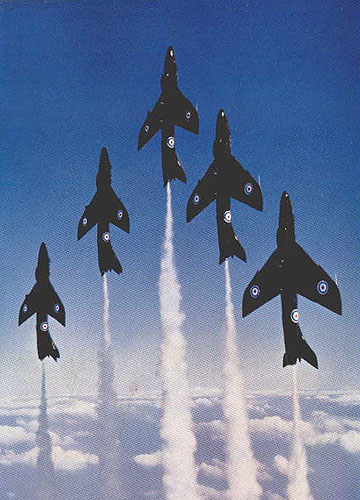 aerobatic team; inter squadron competition
was high, but for that year, all other teams were disbanded and the team
led by Topp was the sole team selected. As a show-stopper, the team was
increased from the norm of four to a five-ship team – increasing the formation
possibilities no end. By Farnborough 1957, the team had built a reputation
among public and service spectators second to none. Imagine the scene
as crowds waited the arrival of the team – to suddenly catch a glimpse
of not five but nine black painted Hunters. The formation pulled up into
a loop, followed by a roll. This was a milestone, since no team anywhere
had flown nine jet formation aerobatics. From being the first with five,
the team became the first with nine!
aerobatic team; inter squadron competition
was high, but for that year, all other teams were disbanded and the team
led by Topp was the sole team selected. As a show-stopper, the team was
increased from the norm of four to a five-ship team – increasing the formation
possibilities no end. By Farnborough 1957, the team had built a reputation
among public and service spectators second to none. Imagine the scene
as crowds waited the arrival of the team – to suddenly catch a glimpse
of not five but nine black painted Hunters. The formation pulled up into
a loop, followed by a roll. This was a milestone, since no team anywhere
had flown nine jet formation aerobatics. From being the first with five,
the team became the first with nine!
The painting of the teams aircraft in an all-black scheme led to the French press at the Paris Air Show 1957 to dub the team 'Les Fleches Noires', giving the Squadron their second well-known nick-name of the 'Black Arrows'. The need for a fighter base near to, and to protect, the city of London had receded, and with expansion at North Weald not being an option, the Squadron re-located in the Summer of 1958 to Wattisham after a brief stay at North Luffenham.
The acceptance that something surprising always came from 'Treble One' culminated in the 1959 Farnborough Show when, still led by Topp, the team led an unheard of 22 Hunters through a formation loop and roll. To this day that feat has never been surpassed or equalled, and was only carried out then by borrowing aircraft from other squadrons. With the high cost of team preparation today, to say nothing of aircraft, this record is, I think, fairly safe in 'Treble One’s hands. When Topp left the unit, in 1959, leaving only seven of the previous year’s aircrew still on strength, the team continued its habit of innovation. Now under Squadron Leader Peter Latham, the idea of flying two formations allowed the crowd to see much more of the formations, and removed the pauses from the programme, while teams re-positioned for the next manoeuvre. Credit has never been given to 111 for this, but the idea of a second team, led by originally by Matt Kemp and later, Brian Mercer, was to influence many to follow – including today’s Red Arrows. Space does not permit me to elaborate but most of what we know in respect of formations and the actual theatre of aerobatic teams was born in the crew-rooms of Treble One.
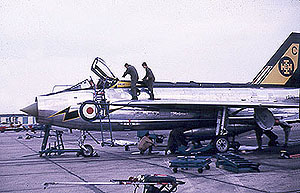
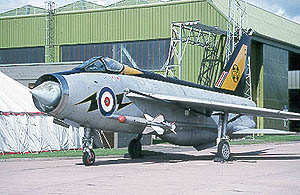 As time took its final
toll of the Hunter, the squadron re-equipped in late 1960 with the English
Electric Lightning. Early days with engine fire-warning problems and
lack of two-seaters were to take toll of the squadron, although eventual
refit with the F3 version led to sixteen years of successful relationship
with the aircraft. 30 September 1974 saw the disbandment of 111 (Lightning)
Squadron at Wattisham and the formation of 111 (Phantom) Squadron at Coningsby
the next day. After work-up the unit headed for colder climes and the
golf courses of Fife, becoming part of the Northern Sector QRA unit at
Leuchars. With first 23 Squadron and later 43 Squadron, the unit was to
maintain this position through the life of the Phantom in RAF service.
As the Phantom FG1 was withdrawn from Fleet Air Arm service with the loss
of the carriers, the Leuchars wing flew ex Navy FG1 machines, while other
units flew the FGR2.
As time took its final
toll of the Hunter, the squadron re-equipped in late 1960 with the English
Electric Lightning. Early days with engine fire-warning problems and
lack of two-seaters were to take toll of the squadron, although eventual
refit with the F3 version led to sixteen years of successful relationship
with the aircraft. 30 September 1974 saw the disbandment of 111 (Lightning)
Squadron at Wattisham and the formation of 111 (Phantom) Squadron at Coningsby
the next day. After work-up the unit headed for colder climes and the
golf courses of Fife, becoming part of the Northern Sector QRA unit at
Leuchars. With first 23 Squadron and later 43 Squadron, the unit was to
maintain this position through the life of the Phantom in RAF service.
As the Phantom FG1 was withdrawn from Fleet Air Arm service with the loss
of the carriers, the Leuchars wing flew ex Navy FG1 machines, while other
units flew the FGR2.
 Northern sector being the
sharp end, so to speak, of QRA it was obvious that, when the Tornado ADV
finally got its act together in the F3 version, these
would head to the North as well. 'Treble One' re-equipped in 1990, where
it remains today – still defending us from any threat from the North.
Northern sector being the
sharp end, so to speak, of QRA it was obvious that, when the Tornado ADV
finally got its act together in the F3 version, these
would head to the North as well. 'Treble One' re-equipped in 1990, where
it remains today – still defending us from any threat from the North.
In this world where the squadrons with great histories are no longer safe from the 'disbanders' sights, it is still impossible to imagine a Royal Air Force without a 'Treble One'.